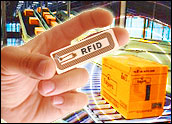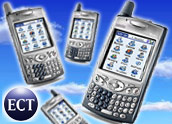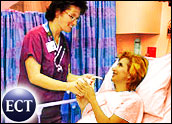
Radio-frequency identification (RFID) has been a highly touted technology in recent years, but concerns — particularly among small and medium-sized businesses (SMBs) — about high costs and actual benefits have hindered its adoption.
That’s gradually changing as developers and vendors focus on systems design, development and interoperability of specific applications in the public and private sectors.
Leveraging the enhanced, more flexible and standardized interoperability inherent in service-oriented architecture (SOA) and on-demand Web services is enabling RFID tags and readers to be used in conjunction with other emerging low-power wireless network standards and technology, such as wireless sensors, actuators and the RuBee networking protocol.
Coincidentally, a variety of new regulatory requirements regarding data security, e-payments, audit trails, asset tracking and traceability are now beginning to spur wider adoption, particularly in the financial, pharmaceutical, healthcare and travel and transportation industries.
“It might be fair to say that RFID and — perhaps to a lesser extent WSN (wireless sensor network) — have gone through their early stages of the ‘hype curve’ (to use the Gartner term) typified by high exuberance followed by ‘troughs of disillusionment’ and are now back on their healthy growth curves of being applied in focused settings where their benefits are well understood rather than ‘hand-wavy,'” commented Roland Acra, president and CEO of wireless sensor systems developer Arch Rock.
Building a Broader Base
“RFID’s cost picture has been one of aggressively targeting very low tag costs very early in the game while infrastructure costs in readers and IT investments upstream have been areas of perceived high cost. This has caused several vendors of RFID tag technology to suffer from lack of profitability and to retrench into less aggressive investment postures,” Acra added.
Persistent efforts to address concerns about data security, accuracy and overall performance, systems integration and interoperability along with new regulatory initiatives are leading a wider range of businesses and public organizations outside of the retail, transportation and supply chain management areas to put RFID systems in place, however.
“While many of the RFID solutions opportunities we saw a few years ago were in the area of consumer driven supply chain, we are now seeing opportunities across a wide range of sectors as companies seek to gain competitive advantage using RFID technology for asset tracking, traceability and location services,” Scott Burroughs, sensor and actuator solutions strategist at IBM, told CRM Buyer.
In the retail and other sectors, such as the pharmaceutical and healthcare industries, lessons learned have led to “a realization that RFID is best applied to items of high value initially, rather than to every last individual pack of tissue paper. The food and pharmaceutical sectors, as well as the logistics area of the military, are some examples of success of using RFID technology recently,” Acra said.
RFID tags will gain wider acceptance in a wide range of organizations and applications, both commercial and for providing public services, said NEC Australia’s Kevin Slade.
“The applications for RFID tags are unlimited and can be adapted to many of our normal everyday functions. A library for example, can have RFID tags on its books to check them in and out, and perform shelf checks, which speeds up manual processes and saves hundreds of hours. RFID can also be used in the health sector to track patients in hospitals and in prisons, to track inmates inside and outside of jails,” Slade told CRM Buyer.
Out There in the Fields
RFID systems are increasingly popping up in SMBs, particularly those involved with a need to track and trace agricultural products and livestock. The Canadian Cattle Identification Agency now requires all newborn cattle in the country to be RFID tagged, explained Robert Moroz, president of R. Moroz.
The firm has been involved with RFID for a little more than 10 years and has deployed more than 100 RFID systems in a variety of industries. In addition to installing systems for the cattle ranchers, meatpackers and distributors, the company has installed systems for tracking fish, pigs, poultry and sheep.
It has also installed RFID systems to track, trace and route newspaper pallets for the Toronto Star, the city’s largest newspaper, and a system for the Toronto Public Library, the second-largest in the world that enables automated self check out, return and sorting of books and other media.
A good part of the company’s success is attributable to the approach it takes when designing and installing RFID systems, which differs a bit from that traditionally taken by RFID vendors, particularly those in North America, Moroz related.
“The focus of our solutions is built around the foundation level, specifically tag-to-reader communications,” he said. “Our view is that any system is only as good as its infrastructure … and that makes it easier to build software and solutions on top of it.”
Real-Time Tracking and Inventory Management
The increasing focus on developing open standards for RFID and integrating RFID systems within larger information systems platforms should pay dividends in terms of fostering adoption among SMBs.
For one, doing so makes it easier and cheaper for RFID developers, vendors and end users to get systems up and running, as well as to realize greater benefits by combining RFID with other emerging wireless network technology, such as wireless sensors and actuators, which have the advantages of multi-hop transmission, as well as data storage, relaying and program execution capabilities.
Pharmaceutical companies and hospitals are adding to a first wave of RFID adoption, according to Moroz. R. Moroz has so far rolled out RFID systems for tracking of pharmaceuticals, equipment and furniture in seven hospitals, including Toronto Sick Kids.
“These systems enable inventory management in real-time with little labor involved even in operating rooms. … Used products are tossed into electronically equipped garbage bins where tags can be read and the resulting data fed into inventory and order management systems,” Moroz explained.









































